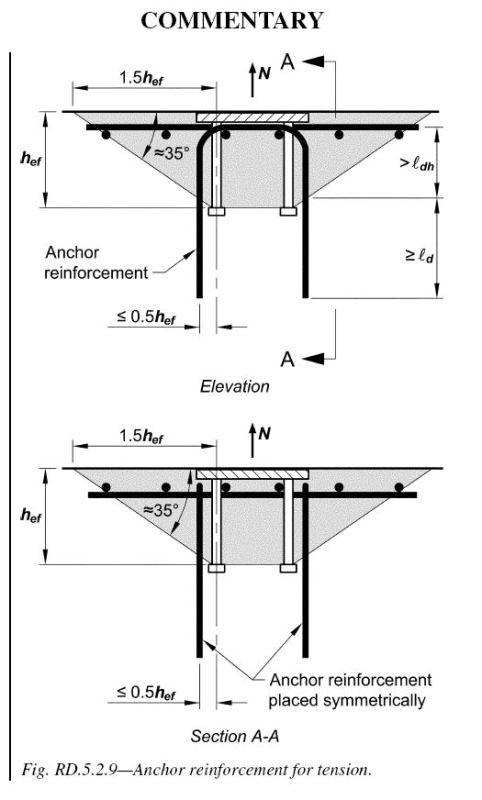pravinagashe
Structural
Dear All,
I have a query pertaining Clause D.5.2.9, Appendix D of ACI-318M-08.
I am posting below the clauses under discussion for your ready reference.

D.5.2.9 — Where anchor reinforcement is developed
in accordance with Chapter 12 on both sides of the
breakout surface, the design strength of the anchor
reinforcement shall be permitted to be used instead of
the concrete breakout strength in determining φNn. A
strength reduction factor of 0.75 shall be used in the
design of the anchor reinforcement.
RD.5.2.9 — For conditions where the factored tensile
force exceeds the concrete breakout strength of the
anchor(s) or where the breakout strength is not evaluated,
the nominal strength can be that of anchor reinforcement
properly anchored as illustrated in Fig. RD.5.2.9.
If factored tensile force exceeds concrete breakout strength, how anchor reinforcement can help when it is not at all receiving the tension directly from base plate?
If we observe the fig. RD.5.2.9 – Anchor reinforcement for tension
1. What advantage we have by providing the Anchor reinforcements as shown in above mentioned figure?
2. Suppose we provide the reinforcement as per the clause, then
The flow of tensile force remains as under…
From Bolts to Concrete > > > > > From Concrete to Anchor reinforcement > > > > > > From Anchor reinforcement to concrete around it.
Thus in no-way the anchor bolts are relieved from taking the tension. Ultimately they are the weak link if Concrete breakout strength governs.
So even though we provide the necessary development length and design the provided reinforcement for 0.75 x As x Fy, the weak link remains anchor bolt only.
3. Even If we match the Anchor reinforcement strength (0.75 x As x Fy) to Concrete breakout strength (Ncbg) by adjusting the “ As ”, what are we achieving?
4. Even after providing this reiforcemnt, code is not allowing us to reduce the edge distances less than 1.5 hef.
5. No where it states that we can have reduced clear cover than 1.5 hef.
6. I was thinking in a way that, this clause may be for the reason,
Every time it is not possible to provide the edge distances of 1.5 hef,(Pedestal size may go very high) thus we can transmit the tension in anchor bolt through Anchor reinforcement to the pedestal with no more need of failure surface to form.
Please explain me what would be the difference in my pedestal size requirement in case if
1. I do not consider the use of anchor reinforcement as per D.5.2.9
2. I do consider the use of anchor reinforcement as per D.5.2.9
In other words,
1. Why to provide Anchor reinforcement, if the failure surface formed is sufficient to transmit the load?
2. And if anchor reinforcement is taking care of the applied tension, why failure cone is needed ? We should be able to reduce the edge distances to less than 1.5 hef.
Regards,
Pravin.
I have a query pertaining Clause D.5.2.9, Appendix D of ACI-318M-08.
I am posting below the clauses under discussion for your ready reference.

D.5.2.9 — Where anchor reinforcement is developed
in accordance with Chapter 12 on both sides of the
breakout surface, the design strength of the anchor
reinforcement shall be permitted to be used instead of
the concrete breakout strength in determining φNn. A
strength reduction factor of 0.75 shall be used in the
design of the anchor reinforcement.
RD.5.2.9 — For conditions where the factored tensile
force exceeds the concrete breakout strength of the
anchor(s) or where the breakout strength is not evaluated,
the nominal strength can be that of anchor reinforcement
properly anchored as illustrated in Fig. RD.5.2.9.
If factored tensile force exceeds concrete breakout strength, how anchor reinforcement can help when it is not at all receiving the tension directly from base plate?
If we observe the fig. RD.5.2.9 – Anchor reinforcement for tension
1. What advantage we have by providing the Anchor reinforcements as shown in above mentioned figure?
2. Suppose we provide the reinforcement as per the clause, then
The flow of tensile force remains as under…
From Bolts to Concrete > > > > > From Concrete to Anchor reinforcement > > > > > > From Anchor reinforcement to concrete around it.
Thus in no-way the anchor bolts are relieved from taking the tension. Ultimately they are the weak link if Concrete breakout strength governs.
So even though we provide the necessary development length and design the provided reinforcement for 0.75 x As x Fy, the weak link remains anchor bolt only.
3. Even If we match the Anchor reinforcement strength (0.75 x As x Fy) to Concrete breakout strength (Ncbg) by adjusting the “ As ”, what are we achieving?
4. Even after providing this reiforcemnt, code is not allowing us to reduce the edge distances less than 1.5 hef.
5. No where it states that we can have reduced clear cover than 1.5 hef.
6. I was thinking in a way that, this clause may be for the reason,
Every time it is not possible to provide the edge distances of 1.5 hef,(Pedestal size may go very high) thus we can transmit the tension in anchor bolt through Anchor reinforcement to the pedestal with no more need of failure surface to form.
Please explain me what would be the difference in my pedestal size requirement in case if
1. I do not consider the use of anchor reinforcement as per D.5.2.9
2. I do consider the use of anchor reinforcement as per D.5.2.9
In other words,
1. Why to provide Anchor reinforcement, if the failure surface formed is sufficient to transmit the load?
2. And if anchor reinforcement is taking care of the applied tension, why failure cone is needed ? We should be able to reduce the edge distances to less than 1.5 hef.
Regards,
Pravin.
